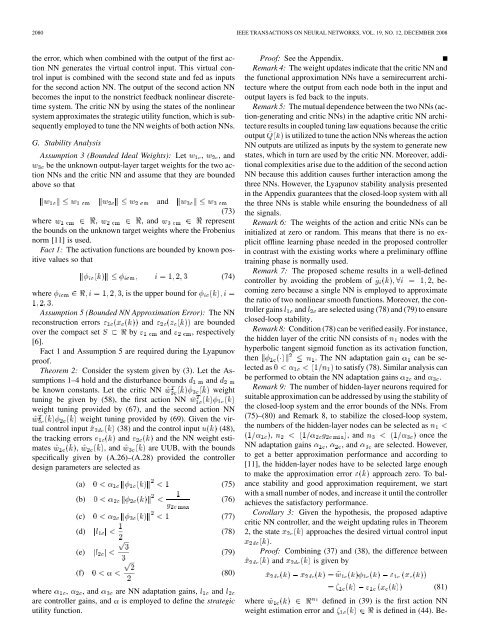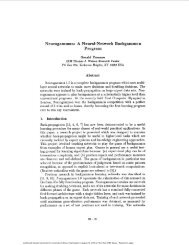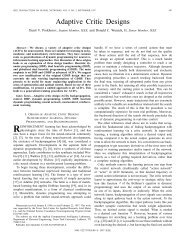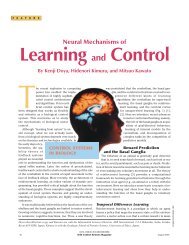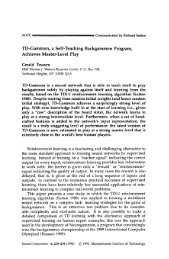Neural-Network-Based State Feedback Control of a ... - IEEE Xplore
Neural-Network-Based State Feedback Control of a ... - IEEE Xplore
Neural-Network-Based State Feedback Control of a ... - IEEE Xplore
Create successful ePaper yourself
Turn your PDF publications into a flip-book with our unique Google optimized e-Paper software.
2080 <strong>IEEE</strong> TRANSACTIONS ON NEURAL NETWORKS, VOL. 19, NO. 12, DECEMBER 2008<br />
the error, which when combined with the output <strong>of</strong> the first action<br />
NN generates the virtual control input. This virtual control<br />
input is combined with the second state and fed as inputs<br />
for the second action NN. The output <strong>of</strong> the second action NN<br />
becomes the input to the nonstrict feedback nonlinear discretetime<br />
system. The critic NN by using the states <strong>of</strong> the nonlinear<br />
system approximates the strategic utility function, which is subsequently<br />
employed to tune the NN weights <strong>of</strong> both action NNs.<br />
G. Stability Analysis<br />
Assumption 3 (Bounded Ideal Weights): Let , , and<br />
be the unknown output-layer target weights for the two action<br />
NNs and the critic NN and assume that they are bounded<br />
above so that<br />
and<br />
(73)<br />
where , , and represent<br />
the bounds on the unknown target weights where the Frobenius<br />
norm [11] is used.<br />
Fact 1: The activation functions are bounded by known positive<br />
values so that<br />
(74)<br />
where<br />
, is the upper bound for<br />
.<br />
Assumption 5 (Bounded NN Approximation Error): The NN<br />
reconstruction errors and are bounded<br />
over the compact set by and , respectively<br />
[6].<br />
Fact 1 and Assumption 5 are required during the Lyapunov<br />
pro<strong>of</strong>.<br />
Theorem 2: Consider the system given by (3). Let the Assumptions<br />
1–4 hold and the disturbance bounds and<br />
be known constants. Let the critic NN<br />
weight<br />
tuning be given by (58), the first action NN<br />
weight tuning provided by (67), and the second action NN<br />
weight tuning provided by (69). Given the virtual<br />
control input (38) and the control input (48),<br />
the tracking errors and and the NN weight estimates<br />
, , and are UUB, with the bounds<br />
specifically given by (A.26)–(A.28) provided the controller<br />
design parameters are selected as<br />
(a) (75)<br />
(b) (76)<br />
(c) (77)<br />
(d) (78)<br />
(e) (79)<br />
(f) (80)<br />
where , , and are NN adaptation gains, and<br />
are controller gains, and is employed to define the strategic<br />
utility function.<br />
Pro<strong>of</strong>: See the Appendix.<br />
Remark 4: The weight updates indicate that the critic NN and<br />
the functional approximation NNs have a semirecurrent architecture<br />
where the output from each node both in the input and<br />
output layers is fed back to the inputs.<br />
Remark 5: The mutual dependence between the two NNs (action-generating<br />
and critic NNs) in the adaptive critic NN architecture<br />
results in coupled tuning law equations because the critic<br />
output is utilized to tune the action NNs whereas the action<br />
NN outputs are utilized as inputs by the system to generate new<br />
states, which in turn are used by the critic NN. Moreover, additional<br />
complexities arise due to the addition <strong>of</strong> the second action<br />
NN because this addition causes further interaction among the<br />
three NNs. However, the Lyapunov stability analysis presented<br />
in the Appendix guarantees that the closed-loop system with all<br />
the three NNs is stable while ensuring the boundedness <strong>of</strong> all<br />
the signals.<br />
Remark 6: The weights <strong>of</strong> the action and critic NNs can be<br />
initialized at zero or random. This means that there is no explicit<br />
<strong>of</strong>fline learning phase needed in the proposed controller<br />
in contrast with the existing works where a preliminary <strong>of</strong>fline<br />
training phase is normally used.<br />
Remark 7: The proposed scheme results in a well-defined<br />
controller by avoiding the problem <strong>of</strong><br />
, becoming<br />
zero because a single NN is employed to approximate<br />
the ratio <strong>of</strong> two nonlinear smooth functions. Moreover, the controller<br />
gains and are selected using (78) and (79) to ensure<br />
closed-loop stability.<br />
Remark 8: Condition (78) can be verified easily. For instance,<br />
the hidden layer <strong>of</strong> the critic NN consists <strong>of</strong> nodes with the<br />
hyperbolic tangent sigmoid function as its activation function,<br />
then . The NN adaptation gain can be selected<br />
as<br />
to satisfy (78). Similar analysis can<br />
be performed to obtain the NN adaptation gains and .<br />
Remark 9: The number <strong>of</strong> hidden-layer neurons required for<br />
suitable approximation can be addressed by using the stability <strong>of</strong><br />
the closed-loop system and the error bounds <strong>of</strong> the NNs. From<br />
(75)–(80) and Remark 8, to stabilize the closed-loop system,<br />
the numbers <strong>of</strong> the hidden-layer nodes can be selected as<br />
, , and once the<br />
NN adaptation gains , , and are selected. However,<br />
to get a better approximation performance and according to<br />
[11], the hidden-layer nodes have to be selected large enough<br />
to make the approximation error approach zero. To balance<br />
stability and good approximation requirement, we start<br />
with a small number <strong>of</strong> nodes, and increase it until the controller<br />
achieves the satisfactory performance.<br />
Corollary 3: Given the hypothesis, the proposed adaptive<br />
critic NN controller, and the weight updating rules in Theorem<br />
2, the state approaches the desired virtual control input<br />
.<br />
Pro<strong>of</strong>: Combining (37) and (38), the difference between<br />
and is given by<br />
(81)<br />
where<br />
defined in (39) is the first action NN<br />
weight estimation error and<br />
is defined in (44). Be-


